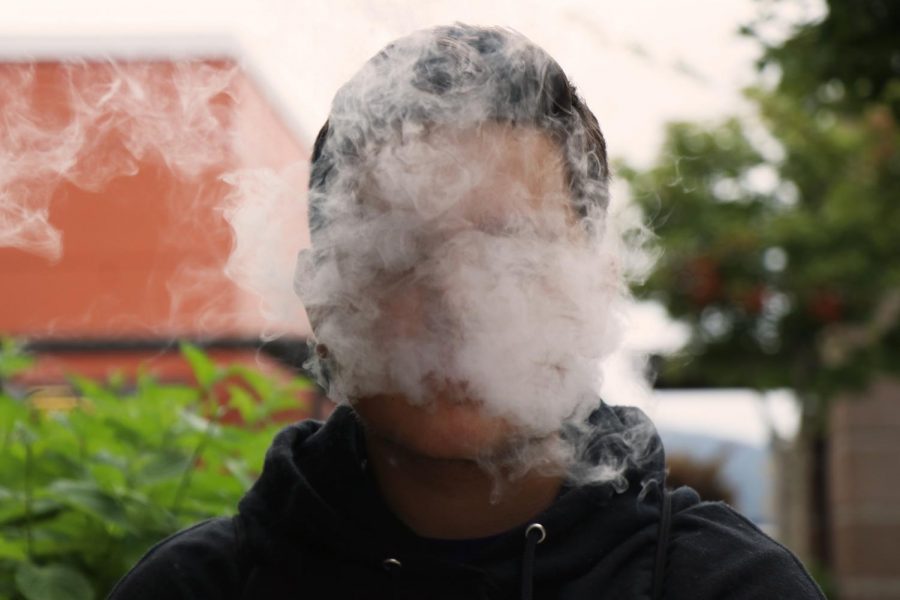The Truth about Vaping
UNAWARE OF EFFECTS Former Issaquah High School student Holden Fitzgerald partakes in vaping daily. Fitzgerald is now 18 years old so it is legal for him to vape. He says, “I really don’t think it’s that bad.”
September 27, 2019
There have been at least nine deaths reported throughout the U.S. and over 530 cases of lung illnesses across the states. The cause of these illnesses are still being looked into, but they may be related to the highly addictive activity known to us as vaping. Most of these cases are young teens, who are not allowed to vape by law. Vape has many flavors and is easy to get and use. This is likely why it has recently become such a problem for high schoolers. Not only did all the patients partake in vaping, but they also had similar symptoms. According to CDC, “Patients’ symptoms ranged from cough, chest pain and shortness of breath to fatigue, vomiting, diarrhea, and fever.” Research is still being done to see if any of the medical cases had anything in common besides their symptoms. Most of the medical cases recorded that the patients vaped on a regular basis.
When people vape, metal particles such as aluminum, nickel, and lead enter their lungs. Having these metals in your system is deadly. There also seems to be a connection to people who smoked Tetrahydrocannabinol, more commonly known as THC, which is found in cannabis. These substances overtime can cause the symptoms mentioned above. It can also lead to lung inflammation, lung tissue damage, or popcorn lungs. Diacetyl, the flavoring found in most vapes, can also lead to lung disease.
The main reasons students vape, according to Issaquah High School students, are peer pressure, anxiety or for popularity. Former IHS student Holden Fitzgerald says, “It’s kinda fun to get buzzed.” The main issue is that students perceive vaping as a safer way to smoke. They do not think there are consequences because vaping is advertised as non-addictive. Junior Amanda Wong thinks that the many flavors of a vape give off a vibe that it is kid friendly, even though highly addictive substances are still in it. Countless studies have shown that vaping can still cause illnesses. It is especially taxing on teens because their brains are nowhere near developed and are not strong enough for teens to be using substances like nicotine or toxicants, which are like pesticides. According to childmind.org, “Their brains are still developing, which makes them more likely to habituate to using drugs and alcohol.” There is still highly addictive substances in vaping methods that get teens started and then eventually get teens addicted to either vaping or worse, cigarettes or alcohol. Say a teen starts vaping at 15 years old. By the time they are 17 they will be so familiar with vaping that it will have no effect on them anymore. They will soon want something stronger that will make them feel better. So they choose to use cigarettes, alcohol or marijuana.
According to Yale Medicine, “Eleven percent of high school seniors, 8 percent of 10th-graders, and 3.5 percent of eighth-graders vaped with nicotine during a previous one month period.” Kids today start at ages like 13 or 14, which is not only bad because of their age, but also if they are starting so young, then in only a few years they may become tired of vaping and will want to start smoking cigarettes or drinking alcohol. Teens need to be taught and shown the deadly effects of vaping so they no longer view it as a safe way to get buzzed, but a highly addictive drug. Sophomore Avery Crowe says that “at least 50 percent, or more” students vape at our school. Other teens agree and say upwards of 80 percent of students vape. “Nearly one in five high school students reported vaping in the past month,” the CDC said last year. Students at IHS have brainstormed new ways to keep teens from vaping at such young ages, such as teaching more about it in health class, or even informing parents about the issue and showing them just how unhealthy it is. Studies from Child Mind Institute, have shown that “nicotine content of one JUULpod is equivalent to one pack of cigarettes.” This information would shock most teenagers and perhaps show them that it still has deadly effects. Teenagers also need to know that there are other ways to cope with anxiety or pressure that do not include getting addicted to a highly toxic drug.




